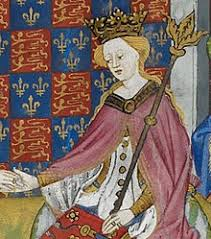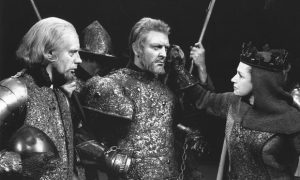For many years attempts have been made to establish that Richard III was not the out and out villain that Shakespeare presents to us, a difficult task since Richard III is one of his most compelling characters in a highly successful play. But he’s not the only character Shakespeare blackened who turns out to be much more complex and interesting when the facts are presented. The Radio 4 programme In Our Time on 24 May 2018 was all about Margaret of Anjou, born in 1430 who became Henry VI’s Queen.
Shakespeare was following the Tudor version of history that insisted the civil unrest and divisions of the Wars of the Roses were ended only by the accession of Henry VII in 1485. In the final speech of Richard III the new king proclaims “England hath long been mad, and scarred herself”, predicting that its citizens will now enjoy “smooth-faced peace,/With smiling plenty and fair prosperous days”. The published accounts by Hall and Holinshed promoted these views.
The Margaret of Anjou we see in Shakespeare’s Henry VI trilogy is a bad woman, vindictive, and violent. On our first sight of her, at the end of Henry VI Part 1 where the Duke of Suffolk captures her in France and at the age of 15 there is little sign of her character, picked up as a political pawn whose existence immediately causes dissention between Suffolk and the Dukes of Gloucester and Exeter.
Margaret, however, would not be told what to do for long. Suffolk praised “Her valiant courage and undaunted spirit” and Edward Hall describes her personality: “This woman excelled all other, as well in beauty and favour, as in wit and policy, and was of stomach and courage, more like to a man, than a woman”. Politically the marriage was “both unfortunate and unprofitable” as “the lords of his realm fell in division among themselves”. When King Henry VI became unable to rule Margaret took over. Although talented, “often time, when she was vehement and fully bent in a matter she was suddenly like a weathercock, mutable and turning”. Hall judges that the villains of the piece were the “venomous serpents, and malicious tigers”, the warring nobles, rather than Margaret who they exploited.
Unlike Richard III, it is still only through Shakespeare that most people have come across her at all, in Richard III. By then an old woman, described as a “hateful withered hag” she is accused of inhumanity at the Battle of Wakefield, when she killed York’s youngest son, taunting York by placing a paper crown on his head, wiping his face with a napkin soaked in the child’s blood before stabbing the father. The others in the scene agree with his judgement: “’twas the foulest deed to slay that babe”, “Tyrants themselves wept when it was reported” and “No man but prophesied revenge for it”. The shocking scene is dramatized in Henry VI Part 3, where she is also given the title by which she has become known:
She-wolf of France, but worse than wolves of France,
Whose tongue more poisons than the adder’s tooth!
A contributor to the Radio 4 programme pointed out how badly Shakespeare gets this wrong as Margaret wasn’t even present at the Battle of Wakefield. As with Richard III, it isn’t fair to put all the blame on Shakespeare, taking his information from Edward Hall’s The Union of the Two Noble and Illustre Families of Lancastre and Yorke. It’s Hall who places Margaret on the battlefield, making her responsible for the merciless beheading of prisoners and setting their heads on poles at the gates of York. The detail about the paper crown is also in Hall, though it’s Clifford who does this after York and his son have been killed. Hall gave Shakespeare the cue from which he created one of the most memorable scenes in all his plays.
The programme drew a connection between Margaret and Helen of Troy. Both were portrayed as the cause of long, bloody and ultimately pointless conflict. Like many in his time, Shakespeare was haunted by the Trojan War, the subject of his own dark play Troilus and Cressida. There’s a reference to the war here too, at a particularly interesting moment. After the King has agreed to marry Margaret against the advice of others, Suffolk likens himself to Paris, who kidnapped Helen sparking off the war between Greece and Troy. These are the final lines of Henry VI Part 1:
Thus Suffolk hath prevail’d; and thus he goes,
As did the youthful Paris once to Greece;
With hope to find the like event in love,
But prosper better than the Trojan did.
Margaret shall now be Queen, and rule the King;
But I will rule both her, the King, and realm.
Shakespeare’s audience would have picked up the reference and understood its meaning, though Suffolk underestimated Margaret. In Our Time, containing much more about the life of this extraordinary women, is still available to the listened to again.



